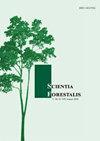Use of light-emitting diodes on the morpho-anatomical characteristics of Corymbia citriodora seedlings
IF 0.4
4区 农林科学
Q4 FORESTRY
引用次数: 0
Abstract
Use of light-emitting diodes on the morpho-anatomical characteristics of Corymbia citriodora seedlings. Abstract With the increase in Corymbia citriodora cultivation in Brazil, it is crucial to evaluate its characteristics in different environments of seedling production, given the different acclimatization strategies under the prevailing environmental conditions in its cultivation. The objective of this study was to evaluate distinct spectral qualities of LEDs lamps in morpho-anatomical characteristics in Corymbia citriodora seedlings. The work was conducted from August 2018 to January 2019, in a growth room. The experimental design used was completely randomized, where the treatments were composed of four spectral qualities of light from white, red (660 nm), blue (450 nm) and blue + red (40% + 60%) LED lamps, with light intensity of 72 µmol m -2 s -1 each bench. For Corymbia citriodora , the different spectral qualities affected characteristics such as leaf blade thickness, leaf area, dry matter, stomatal density, decreased chlorophyll b and total chlorophyll content under red LED and caused lower epidermis thickness under blue LED cultivation. The use of white spectral quality is the most appropriate and favors the dispatch of seedlings at 102 days after emergence, both in the parameters evaluated for leaf area index and for dry matter. influence on the leaf area index, dry matter, chlorophyll, stomatal density and anatomy.利用发光二极管研究香茅幼苗的形态解剖特征
利用发光二极管研究香茅幼苗的形态解剖特征。摘要随着巴西柠檬茅栽培量的增加,在不同的环境条件下,柠檬茅的驯化策略不同,因此评估其在不同环境下的育苗特性至关重要。本研究的目的是评估不同的光谱质量的led灯的形态解剖特征的香茅幼苗。这项工作于2018年8月至2019年1月在一个生长室内进行。实验设计采用完全随机化设计,其中处理由白色、红色(660 nm)、蓝色(450 nm)和蓝+红(40% + 60%)LED灯的四种光谱质量组成,每个台的光强为72µmol m -2 s -1。不同光谱质量对柠檬草叶片厚度、叶面积、干物质、气孔密度等性状有影响,在红色LED下叶绿素b和总叶绿素含量降低,在蓝色LED下导致下表皮厚度增加。在叶面积指数和干物质参数评价中,采用白光谱质量最适宜,且有利于幼苗在羽化后102 d的调度。对叶面积指数、干物质、叶绿素、气孔密度和解剖结构的影响。
本文章由计算机程序翻译,如有差异,请以英文原文为准。
求助全文
约1分钟内获得全文
求助全文
来源期刊

Scientia Forestalis
Agricultural and Biological Sciences-Forestry
CiteScore
1.00
自引率
0.00%
发文量
39
期刊介绍:
Scientia Forestalis is a scientific publication of the IPEF – Institute of Forest Research and Studies, founded in 1968, as a nonprofit institution, in agreement with the LCF – Department of Forest Sciences of the ESALQ – Luiz de Queiroz College of Agriculture of the USP – São Paulo University. Scientia Forestalis, affiliated to the ABEC – Brazilian Association of Scientific Publishers, publishes four issues per year of original papers related to the several fields of the Forest Sciences.
The Editorial Board is composed by the Editor, the Scientific Editors (evaluating the manuscript), and the Associated Editors (helping on the decision of acceptation or not of the manuscript, analyzed by the Peer-Reviewers.
 求助内容:
求助内容: 应助结果提醒方式:
应助结果提醒方式:


